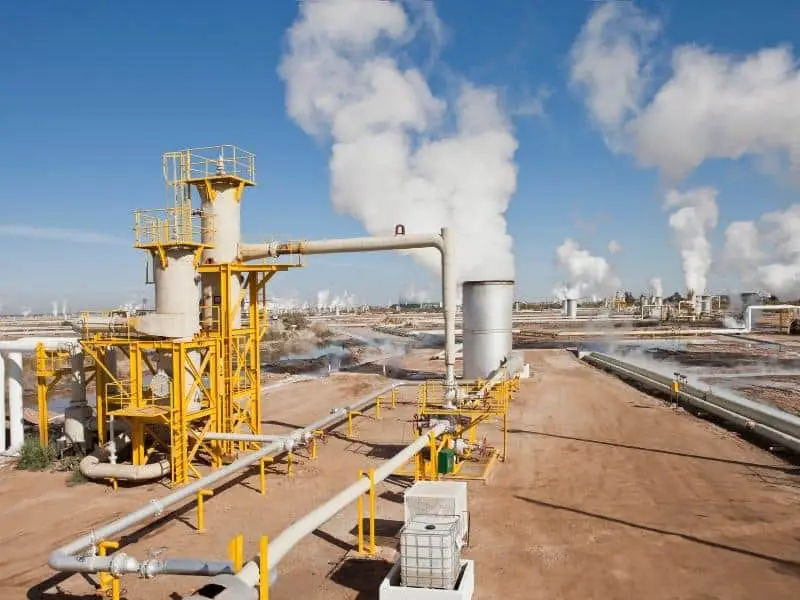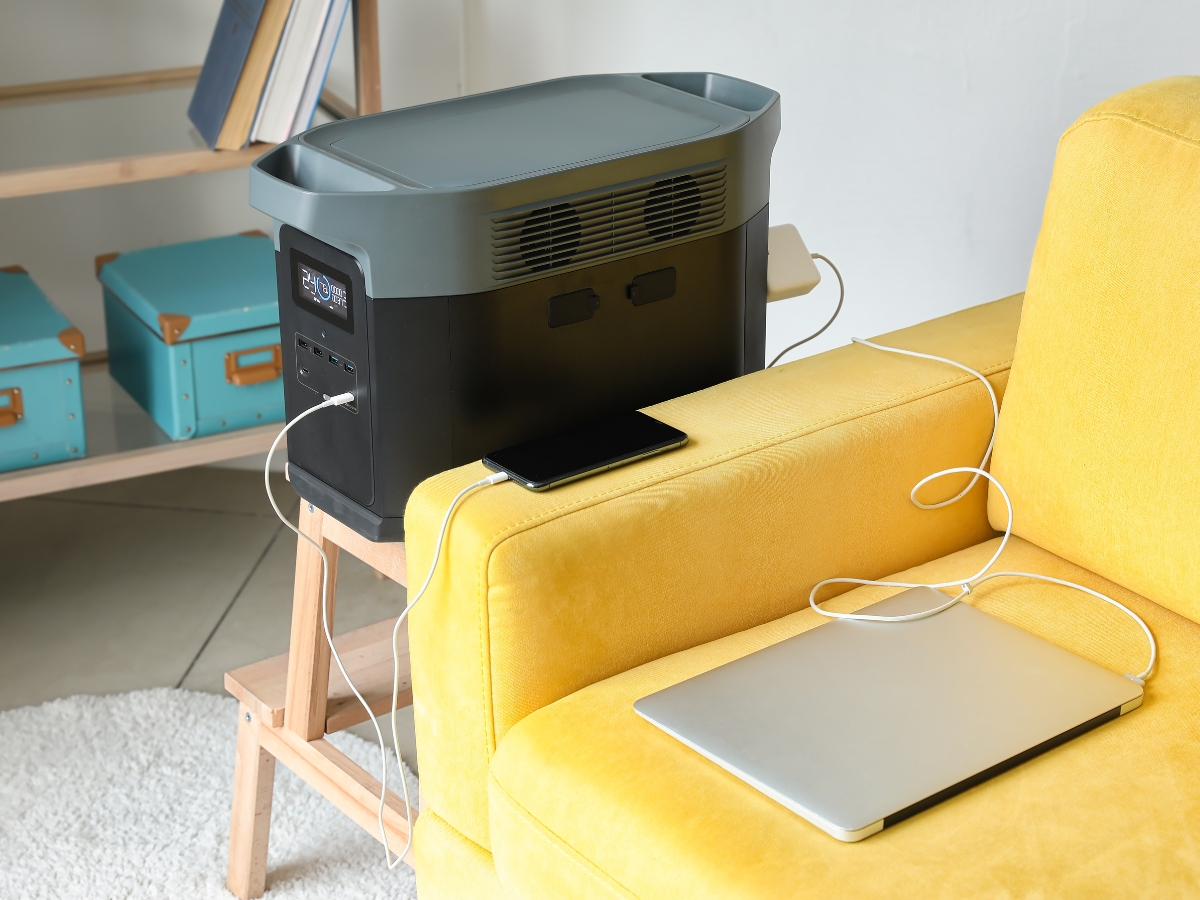Geothermal energy is the third-largest renewable energy source, second to biomass and hydropower. It is an almost never-ending clean energy supply created deep in the earth’s molten core.
Examples of geothermal energy are:
- Geothermal power plants that use three different methods to generate electricity
- Geothermal heating for homes using geothermal heat pumps
- Spas that use geothermal energy
- Greenhouses that use the heat and moisture
- Hot springs
- Natural geysers
- Fumaroles
This phenomenal energy source is abundant on our planet, so let’s explore these examples in more detail.

What Are The Three Types Of Geothermal Power Plants?
The three different types of power stations are, and each utilizes the energy a little differently:
- Dry steam power stations
- Flash steam power stations
- Binary cycle power stations
Geothermal power plants are found worldwide and are a great example of how this powerful energy can provide electricity to homes and businesses. Around the world, 26 countries use geothermal energy to produce electricity.
Global estimates project the potential of geothermal energy to range between 35 gigawatts and two terawatts. With only about 8% of the total capacity being used, plenty is still to come.
The geothermal lifespan is estimated at between 5000 and one million years, so; we should not be running out of this available energy source any time soon.
Using different systems to generate power, geothermal power stations are some of the cleanest energy producers in the world. In countries like Iceland, 26% of that nation’s electricity supply comes from geothermal power.
Compared to coal that produces more than 1 ton of CO2 per kW of power, geothermal only produces around 45kg of CO2, and much of the water used and minerals and salts produced are recycled back into the earth to avoid depleting the geothermal source.
Dry Steam Geothermal Power Stations
Dry steam power plants are the oldest kind, and they use steam coming out of vents to drive turbines that create electricity. The steam comes out at a temperature of 302°F and drives the turbines directly. The condensed water is fed back into the system and reused.
Flash Steam Geothermal Power Stations
This system uses superheated water drawn up from the geothermal source and is stored in low-pressure tanks. The steam released from that process is then used to drive the turbines and create electricity.
The temperature of this water is usually above 360°F, and it needs to be at this heat to be effective.
Binary Cycle Geothermal Power Stations
This is the most common form of geothermal energy used in power stations. This system uses cooler water than the other types of electrical generation.
Bypassing this moderately hot water over a liquid with a lower boiling point than water – in most cases, isobutene – the steam released from the isobutene is captured and used to drive the turbines.
A few more reasons why geothermal is better than coal:
- It’s cheaper than coal, costing around 3c -3,5c per kWh than coal at 5,5 c per kWh produced.
- It’s always on, while coal only has around 70% availability
- It’s completely clean, meaning no additional fuel is required to create power.
Enhanced Geothermal Systems
To utilize geothermal energy, it needs to have heat, be permeable, and have liquid, and in some cases, the area may only have one or two of those properties available. This is another example of how geothermal energy is ‘created’ using smart engineering.
Firstly, an injection well is drilled to depths ranging from half a mile to almost three miles deep, and then cold water is injected into the good space under high pressure.
The water causes the rock to either create new fractures, expand old ones or dissolve, and in doing so, the underground fluid reservoir is born. Then water is pumped through the well and absorbs the heat from the rock.
This hot water, called brine, is pumped through pipes where it warms a secondary fluid with a low boiling point, creating steam that powers turbines to create electricity.
The problem with this is that it can often cause progressively more severe seismic events like earthquakes due to the water being pumped into the ground.
Are Geothermal Power Stations More Space Efficient
One of the major benefits of a geothermal power stations is that they are compact. The space they need to generate the same amount of electricity is substantially lower than any other power generation.
As a comparison, a geothermal plant big enough to produce a gigawatt-hour or one million kilowatts for an hour only requires 404 square miles of land. Using wind energy to produce that same power level would require 1335 square miles!
A solar power generation plant would need around 3237 square miles, and a coal-fired power plant would require 3642 square miles! This is more than nine times the land-space needed than geothermal would require.
How Is Geothermal Energy Used For Heating Homes?
In countries where the climates are colder and they have an abundance of geothermal energy available, it has been harnessed to provide warmth to homes that would otherwise have to use electricity.
In Iceland, for example, 90% of all homes are heated using geothermal energy. This makes keeping warm both cheap and environmentally friendly.
Also, much of the by-products of this process are recycled back into the earth, reducing waste and emissions.
How Do Geothermal Heat Pumps Work?
Geothermal heat pumps use a ground loop system to move heat from the ground to the home and back, depending on whether they are being used to heat or cool the house, as they can do both.
They are highly efficient as they don’t rely on variable atmospheric conditions but rather use the very consistent temperatures found between 6 and 10ft underground.
Not only do they warm or cool the home, but they also provide hot water, reducing the dependence on water heating systems that consume power.
Using a series of liquid-filled pipes, the heat pump will move heat from the building into the pipes allowing for cooling and the reverse process when heating is required.
Using high-pressure refrigerant, the heated liquid flows through the underground pipes, and the earth removes the heat from the house in summer and releases it into the ground rather than the air.
The heat is pumped into the houses using the same system in winter, and the colder air is removed from the building.
The attraction of geothermal heat pumps is their efficiency and longevity. The ground loop components have a lifespan of around 50 years, with the components inside the house lasting up to 25 years.
Compare that to conventional systems that last around 10-15 years.
Spas Use Geothermal Energy For Heat And Steam
If you have ever been to a spa, that superheated water you are lying in could well be coming from the earth itself! Instead of relying on electricity to generate heat and steam, geothermal vents near the spa can provide more than enough hot water and steam to keep them going for centuries!
The first recorded use of a geothermal bath dates back to China around 3 BC, so the healing properties of this abundant energy source have been long recognized and respected in human history.
Aside from the hot water and steam, geothermal energy saves money and reduces the CO2 footprint. They can utilize this energy source for baths, showers, and temperature maintenance in the spa building.
Why Geothermal Greenhouses Make Sense
Greenhouses rely on a mixture of heat and moisture to be effective. While this is usually done using the sun and internal watering systems, connecting a greenhouse to a geothermal source is a match made in heaven!
Geothermal energy provides both of these in abundance with a lake nearby as heating coils are installed at the bottom of the lake, then anti-freeze is added to keep the temperature constant, and the steam and gas are then fed into the greenhouse.
The earth controls the internal greenhouse temperature and can remain consistent throughout the year.
Geothermal Energy Doesn’t Only Grow Plants
Geothermal energy has other applications in helping farmers of all kinds grow and maintain their livelihoods, from keeping plants and vegetables warm in winter to cultivating shellfish, prawns, and even alligators!
Geothermal energy can bring heat to the cold ground allowing crops to flourish that would otherwise die, and it is also used to kill pests, diseases, and fungus that would be harmful under normal conditions.
This is done by applying steam directly to the soil, and that same heat can also be utilized to dry crops and timber and prevent them from becoming moldy and unusable after harvesting.
Hot Springs And Human Health
The benefits of hot springs for human health are well known and chronicled going back to Roman times and beyond. As water comes into contact with hot rock, the hot springs are created.
The heat from the earth heats the water, and it bursts out, bringing with it the benefits of geothermal energy from deep in the ground. Hot springs attract people from a tourist perspective or a therapeutic one.
There are both economic and health benefits as hot springs can create revenue from tourists and bathers alike. Hot springs are one of the most accessible and easily recognizable forms of geothermal energy.
While some hot springs are the right temperature range for people to bathe in, others are far too hot and would cause severe scalding or even death, and these are best viewed from a safe distance.
Balneotherapy – An Example Of Using Geothermal Energy For Healing
Based on a combination of bathing and drinking mineral-rich water, balneotherapy treats disease in humans using the benefits of geothermal energy. Many spas worldwide use this, the most famous being the Blue Lagoon Spa in Iceland.
Ironically, this is not a natural hot spring and is man-made by using water from a local geothermal power plant and pumping it over silica- and sulfur-rich lava beds.
Famous US locations offering this therapy are Hot Springs in Arkansas and Warm Springs in Georgia.
Natural Geysers Are A Rare Example Of Geothermal Energy
Everyone knows about ‘Old Faithful’, a natural geothermal geyser located in Yellowstone National Park and called so as it erupts every 60 to 90 minutes.
The park itself sits atop an enormous volcano, and the geothermal energy that drives Old Faithful is a subtle reminder of the tremendous forces and heat at work below.
Geothermal geysers can shoot hundreds if not thousands of superheated water into the air on each eruption, and they are spectacular to witness. Natural geysers require a specific combination of factors to align for them to occur.
To have a natural geothermal geyser, you need a vent or crack in the earth for the water to escape, a subsurface water reservoir, hot underground rocks, and a groundwater source.
These phenomena are quite rare despite common belief. Only the USA, Chile, New Zealand, Iceland, and Russia have them, so if you plan a visit to a natural geyser, take the time to appreciate it as a unique example of geothermal energy.
What Are Fumaroles?
A fumarole is a vent that occurs near a volcano or hot spring as these are required for the water heated by the hot rock underneath to escape. Fumaroles can be tapped easily as their energy can be extracted without a pump from the earth’s surface.
Direct access to the heat from a fumarole requires little or no modification as it flows out under natural pressure and process, but these can be unstable and disappear with the earth’s cycle.
When fumaroles around a volcano stop, that means that the volcanic deposit has cooled off, but these vents can last hundred or thousands of years or only a matter of weeks or months, making them unstable in terms of consistent energy supply.
The potential for geothermal energy is immense, and it is believed that by the year 2050, geothermal energy could account for around 10% or more of the total global power supply.
As these examples of geothermal energy demonstrate, there exist multiple applications for this abundant and reliable gift from the earth.
Resources




